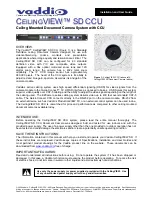
326
THE HASSELBLAD MANUAL
(except with special color matching tubes). Film and fl uorescent tube manufacturers publish
charts showing which CC fi lters produce the most satisfactory results.
The Decamired Filter System
In the Wratten fi lter system, there is no direct relationship between the color temperature of
the light and the fi lter value. In the Decamired system that Hasselblad used, the light and fi lter
values are directly related to each other and can be matched with a DM value equal to the dif-
ference in the DM values of the fi lm and the light source. For example, if a DM 31 fi lm is used
with DM 28 light, you need a 3-DM value fi lter; CR 3 (red) in this case because the light is
bluer. The fi lters within each color can be combined to obtain different correction values.
EXPOSURE INCREASE
With the exception of UV, haze, and some light balance and compensating types, where the
light loss is negligible, lens settings must be adjusted when the meter reading is made with
a handheld meter. The necessary exposure increases may be indicated either in fi lter factors
or in aperture values. The two are not the same. When the increase is indicated in aperture
values, increase exposure by the indicated value; for example, two
f
stops if the value is 2. If
indicated in fi lter factors, convert the factors into the aperture values shown in Table 17-4.
Hasselblad fi lters carry all the necessary information engraved on the rim. For example, a fi lter
engraved 60 2 X YG–1 has a size of 60 mm, a color of yellow-green, and a fi lter factor of 2,
requiring an exposure increase of 1 EV value. Filter colors are designated as follows: Y
yel-
low, YG
yellow-green, G
green, O
orange, and R
red.
Table 17-4
Filter Factors and
f
Stops/EV Values
Filter
factor
1.5 2 2.5 4 6 8 16 32 64
Increase in EV or
f
stops ½ 1 1½ 2 2½ 3 4 5
6
When the meter reading is made through the lens, as in the Hasselblad H and 200 cam-
eras, or with a meter prism viewfi nder on a 503 or other V system camera, the light loss is
automatically adjusted in the meter reading.
POLARIZING FILTERS OVER LIGHT SOURCES
You can polarize light from tungsten lights or electronic fl ash by placing a polarizing fi lter
over the light source. The polarizing fi lter on the camera lens then eliminates all refl ections, at
all angles, from all materials. This procedure is necessary to eliminate refl ections on bare metal.
It is also a superb approach for copying (Figure 17-9). To be most effective, the polarized
light must illuminate the subject or document from an angle between 30 and 40 degrees. You
then turn the polarizing fi lter on the camera by visually examining the image on the focusing
screen.
Summary of Contents for Digital Camera
Page 1: ......
Page 2: ...The Hasselblad Manual ...
Page 3: ...This page intentionally left blank ...
Page 13: ...This page intentionally left blank ...
Page 166: ...Heidi Niemala Photographed for clothing designer with a 150mm lens ...
Page 167: ...Heidi Niemala Editorial portrait with a 150mm lens ...
Page 168: ...Heidi Niemala Photographed with a 50mm lens during a sand storm at White Sands ...
Page 200: ...Jonathan Exley Lifestyle Designer Kathy Ireland Courtesy of kathyireland com ...
Page 244: ...Marco Grob A make up test shot made with an HC Macro 4 120mm lens on an H camera ...
Page 398: ...Close Up Photography on Film or Digital 383 ...
Page 400: ...Jonathan Singer ...
Page 401: ...Jonathan Singer ...
Page 421: ...This page intentionally left blank ...
















































